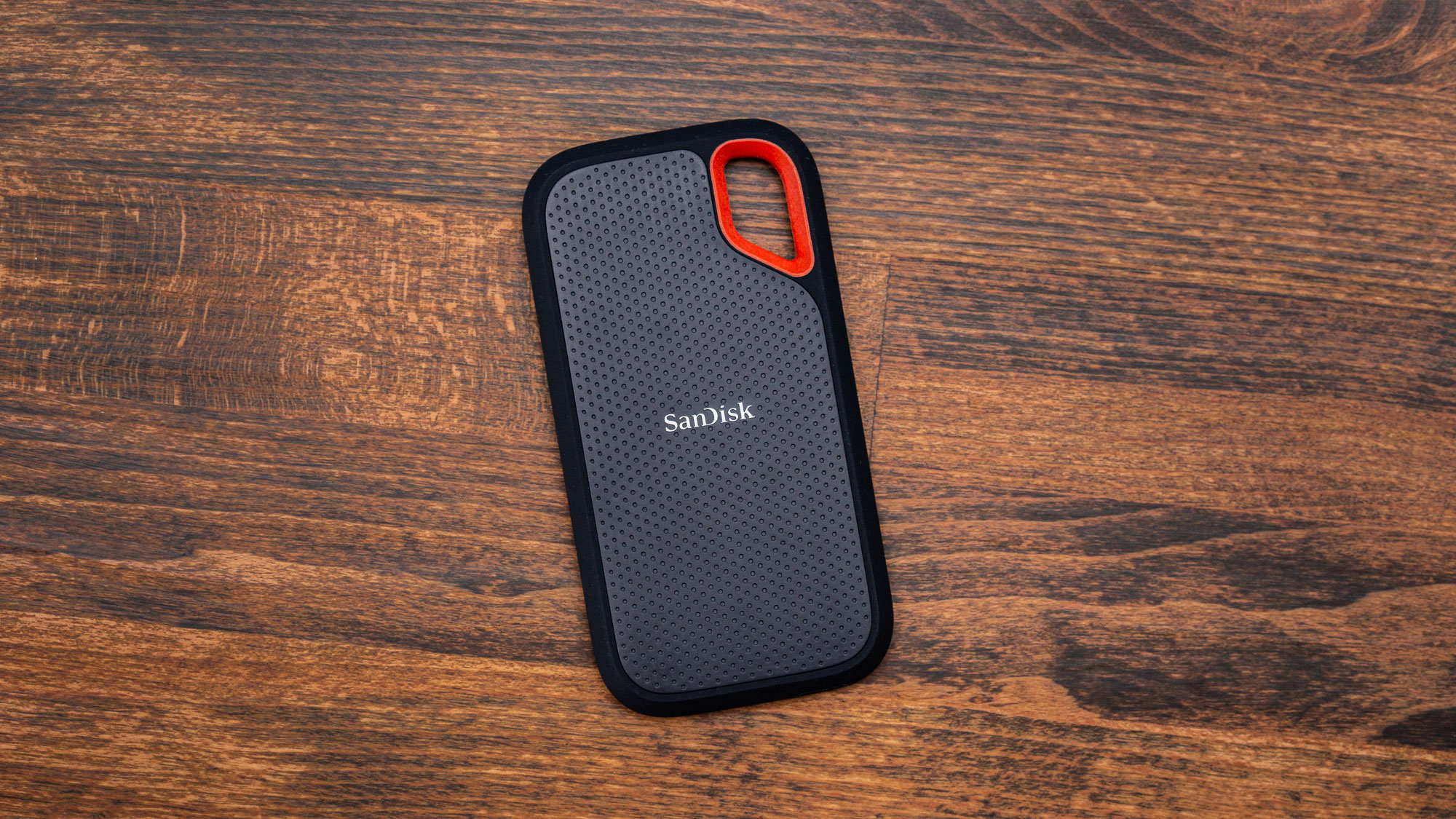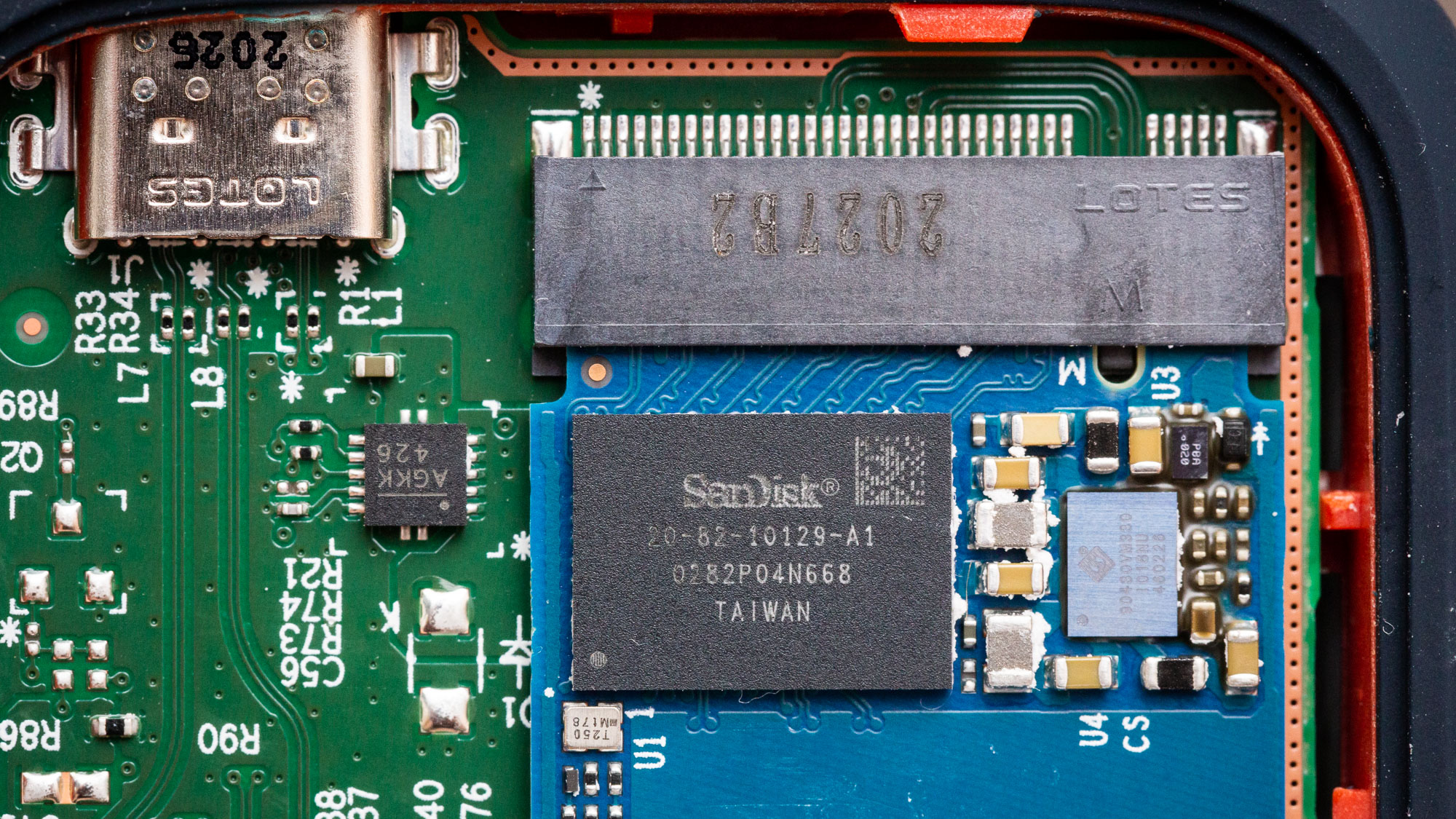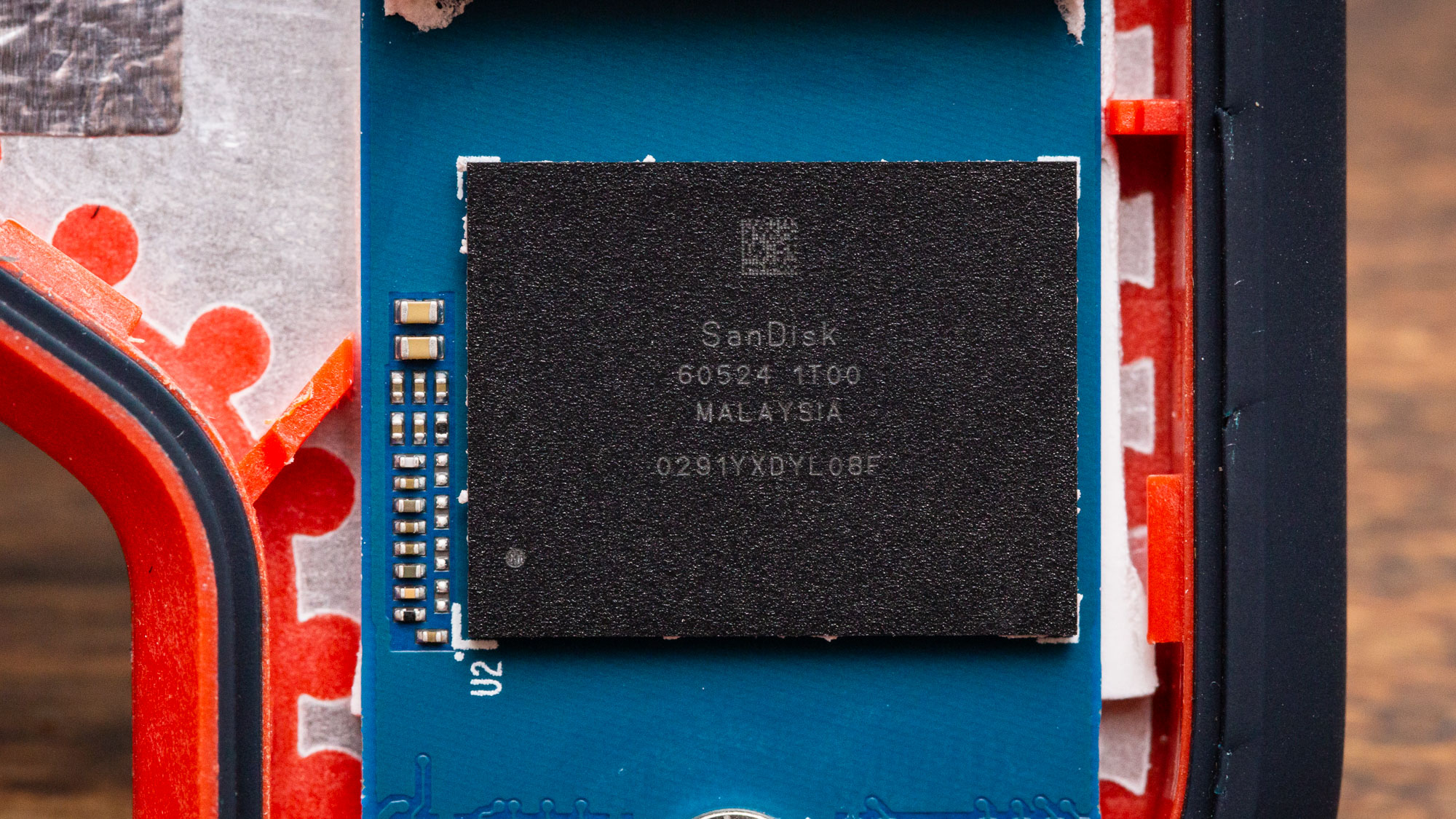Tom's Hardware Verdict
SanDisk’s Extreme v2 packs double the performance of the original and ups the security with hardware-accelerated full disk encryption. This, along with a durable design and five-year warranty, makes the Extreme v2 one of the best 10 GBps NVMe portable SSD for content creators on the go.
Pros
- +
Competitive and consistent performance
- +
AES 256-bit Full Disk Encryption
- +
Weather-resistant
- +
Durable, grippy finish
- +
5-year warranty
Cons
- -
No power indicator
- -
Short cable for desktop use
Why you can trust Tom's Hardware
Leveraging a USB 3.2 Gen 2 interface, WD’s Blue SN550E SSD, and a now-iconic design, SanDisk’s Extreme v2 is a great performing portable SSD that’s built secure and to endure the elements. Reasonably priced, it compares well in today’s market and is easy to recommend.
With an already award-winning and durable design, SanDisk’s focus for the Extreme v2 was to improve on what works, rather than start from scratch. Most of the changes in the v2 are internal rather than external. The company kept the old shell, scaling it up a little to account for faster NVMe-supporting hardware, and upping the performance from 5 Gbps to 10 Gbps to enable rapid data backups or reading when on the move.
SanDisk also upgraded the security significantly. No longer will you have to await the slow transfer speeds associated with the company’s old 128-bit software encryption. The AES 256-bit hardware-accelerated encryption support enables simple to use password security, making the SSD a good fit for those who carry sensitive data around with them.
Specifications
| Product | Extreme v2 500GB | Extreme v2 1TB | Extreme v2 2TB | Extreme v2 4TB |
|---|---|---|---|---|
| Pricing | $94.99 | $159.99 | $309.99 | $699.99 |
| Capacity (User / Raw) | 500GB / 512GB | 1000GB / 1024GB | 2000GB / 2048GB | 2000GB / 2048GB |
| Interface / Protocol | USB-C / USB 3.2 Gen 2 | USB-C / USB 3.2 Gen 2 | USB-C / USB 3.2 Gen 2 | USB-C / USB 3.2 Gen 2 |
| Included | USB Type-C cable and USB Type-A adapter | USB Type-C cable and USB Type-A adapter | USB Type-C cable and USB Type-A adapter | USB Type-C cable and USB Type-A adapter |
| Sequential Read | 1,050 MBps | 1,050 MBps | 1,050 MBps | 1,050 MBps |
| Sequential Write | 1,000 MBps | 1,000 MBps | 1,000 MBps | 1,000 MBps |
| Interface Controller | ASMedia ASM2362 | ASMedia ASM2362 | ASMedia ASM2362 | ASMedia ASM2362 |
| NAND Controller | WD Architecture | WD Architecture | WD Architecture | WD Architecture |
| DRAM | DRAMless | DRAMless | DRAMless | DRAMless |
| Storage Media | WD 96L TLC | WD 96L TLC | WD 96L TLC | WD 96L TLC |
| Default File System | exFAT | exFAT | exFAT | exFAT |
| Endurance | "IP55 water-dust resistant; 2-meter drop protection" | "IP55 water-dust resistant; 2-meter drop protection" | "IP55 water-dust resistant; 2-meter drop protection" | "IP55 water-dust resistant; 2-meter drop protection" |
| Security | AES 256-bit hardware encryption | AES 256-bit hardware encryption | AES 256-bit hardware encryption | AES 256-bit hardware encryption |
| Dimensions (L x W x H) | 101 x 52 x 9 mm | 101 x 52 x 9 mm | 101 x 52 x 9 mm | 101 x 52 x 9 mm |
| Weight | 63 g | 63 g | 63 g | 63 g |
| Part Number | SDSSDE61-500G-G25 | SDSSDE61-1T00-G25 | SDSSDE61-2T00-G25 | SDSSDE61-4T00-G25 |
| Warranty | 5-Years | 5-Years | 5-Years | 5-Years |
SanDisk’s Extreme v2 comes in capacities of 500GB, 1TB, 2TB, and 4TB, with prices ranging from $0.15-$0.19 per GB. Rated for up to 1,050/1,000 MBps read/write, the SanDisk Extreme v2 can deliver some very responsive performance, but these are peak figures. Due to a small static SLC cache, the Extreme v2 will degrade to direct-to-TLC speeds quickly. The smallest capacity will suffer the most. However, while not bus saturating, sustained performance will remain reasonable with the 1TB and 2TB models.
SanDisk’s Extreme v2 comes with an IP55 rating, AES 256-bit hardware encryption support, and a long warranty to ease concerns when traveling with your storage. The Extreme v2 has been tested to withstand water flow at a rate of 30kPa for three minutes, and dust contact does not interfere with operation. On top of this, SanDisk backs the Extreme v2 with a longer five-year warranty over its predecessor’s three-year warranty.
Software and Accessories



The Extreme v2 comes with a short 6-inch USB Type-C cable and a 1-inch long Type-C to Type-A adapter. It also comes with encryption management software to quickly set up a password to secure your data.
A Closer Look




SanDisk’s Extreme v2 is a bit bigger than the original, measuring 101 x 52 x 9 mm and weighing in at under 63 grams. With a carabiner loop integrated and a durable silicone coating, the Extreme v2 features a functional, portable, and enduring design for those on the move in tough conditions. But unlike the Extreme Pro, the Extreme v2’s case and internal structure is made of plastic rather than rigid aluminum. This makes for a small and compact design that is also pretty light, but a little less resistant to twists and bending.
Get Tom's Hardware's best news and in-depth reviews, straight to your inbox.
The company opted for an ASMedia ASM2362 USB 3.2 Gen 2 to PCIe 3.0 x2 bridge chip in the design, similar to the company’s WD My Passport SSD. Integration of a near full-length strip of thermal tape between the WD Blue SN550E drive and the front cover aids in maintaining cool operation. Both the SSD and the ASMedia ASM2362 support active-state power management and therefore will scale down power consumption when at idle and help reduce overall heat. It also supports thermal throttling, prioritizing data integrity over performance in high-temperature conditions.


WD’s Blue SN550E is the company’s external-optimized SN550 Blue variant. It leverages a 4-channel DRAMless NVMe 1.3-compliant SSD controller with a multi-gear Low-Density Parity-Check (LDPC) ECC. While this SSD lacks DRAM for caching the FTL mapping table, it leverages internal SRAM to help optimize metadata updates. The SSD’s hardware also supports Trim when formatted via a supported file system such as NTFS, helping aid performance consistency over the device’s lifespan.
The controller interfaces with sixteen dies of WD’s BiCS4 96L TLC flash. This NAND measures 512Gb in density and features a 2-plane architecture, half the plane count of most of Micron’s 96L TLC, and operates at speeds of up to 800 MTps. While it features half the plane count of the competition, WD implements advanced algorithms to optimize both SLC and direct-to-TLC performance.
MORE: Best SSDs
MORE: How We Test HDDs And SSDs
MORE: All SSD Content

Sean is a Contributing Editor at Tom’s Hardware US, covering storage hardware.
-
Co BIY How often does an external SSD drive need to be powered up or plugged in to maintain the data ?Reply
Does flash data have a half-life ? -
deesider Reply
It seems that the most often quoted retention time is 10 years.Co BIY said:How often does an external SSD drive need to be powered up or plugged in to maintain the data ?
Does flash data have a half-life ?
There is an Anandtech article that discusses findings that a worn out drive (at the end of its endurance rating) can lose data much faster depending on temperature: https://www.anandtech.com/show/9248/the-truth-about-ssd-data-retention -
Uiflorin Flash memory stores the information as electric charge (electrons for negative charge, or lack of electrons for positive charge) in a buried and insulated (in oxide) gate of a mosfet transistor. Once this charge is transferred into that gate, it can stay there for a period of time expressed in years, or tens of years, and it can still be read correctly as 1 or 0. This is called RETENTION time. After that period, the charge wil statistically leak out and be insuficient for that bit of information to be read correctly. Depending on the technology, a bit of information is stored as no charge (logic level 1, or bit 1), while the other (logic level 0, or bit 0) as charge present in the transistor, so after the retention time only the logic level 1 will be ready correctly, because there was no charge to leak out. Anyways, that's irrelevant, if some of the 0 bits are not read, the information is lost. For flash memory this time is 10 years as guarantied retention time, for eeprom is 100 years in normal storage conditions. Temperature affects the retention, higher temperature leads to higher leakage of charge from that insulated gate, so better keep the flash cards cool.Reply
Now, to answer your question, powering up the drive containing that memory does not refresh it's content. You can keep it powered up continuously, the information stored in the transistors is NOT UPDATED OR REFRESHED by the power applied to device, unless you write again the information. This principle of refreshing the data from time to time is used in the RAM memory in computers, and losing power leads to losing data.
Hard drives based on magnetic retention of data are better in this respect, since the retention time is greater if the device is kept properly.
Another thing about the flash memory is the indurance of the cell, how many times the memory cell accepts write/erase cycles until it starts to "wear" and not store anymore the information. That number is in the hundreds now days. If you read correctly the specification of an SSD drive, you will find a specification called "TBW", total bytes written. Dividing that number by the capacity of the drives yields the number of erase/write cycles that will wear the cells.
Flash memory based drives have now implemented a special "wear" algorithm, such that new data is written on cells that are not progammed with data, and so files are moved continuosly across the drive to mentain a balance of erase/program for all the cells, otherwise if a file is continuously written and modified on the same memory cells, these will wear after those few hundred of cycles and not be able to be used anymore. That is why a worn out SSD drive, that has reached a TBW spec, will not retain the information for long. -
Co BIY ReplyUiflorin said:Now, to answer your question, powering up the drive containing that memory does not refresh it's content. You can keep it powered up continuously, the information stored in the transistors is NOT UPDATED OR REFRESHED by the power applied to device, unless you write again the information. This principle of refreshing the data from time to time is used in the RAM memory in computers, and losing power leads to losing data.
Interesting. I assumed that "refreshing" the charges/data was one of the routine maintenance tasks of the SSD controller and assumed that it would be done on a routine/scheduled basis. If the data is stable for 10 years then it makes sense that this is not done. I assumed the stable time was a lot less then 10 years.
It seems like "refreshing" the charges should be a maintenance function of devices. -
deesider Reply
I have a feeling that the wear-leveling algorithms will take care of that if the drive in still in use. So even data that is never changed or moved by the user will be refreshed by moving it to different cells to ensure even wear of all cells across the drive. Otherwise old data would be hogging the nice and shiny, barely used cells, leaving the sometimes empty cells to wear down and brick the drive.Co BIY said:Interesting. I assumed that "refreshing" the charges/data was one of the routine maintenance tasks of the SSD controller and assumed that it would be done on a routine/scheduled basis. If the data is stable for 10 years then it makes sense that this is not done. I assumed the stable time was a lot less then 10 years.
It seems like "refreshing" the charges should be a maintenance function of devices. -
Co BIY A question that I think needs answered authoritatively by the device manufacturers is:Reply
If I back up important archive data to an SSD and then disconnect it and place it in a box on a shelf in normal storage conditions, Then how long will my data remain in perfect condition?
Will that time be extended by plugging it in and powering up every year or so ?
